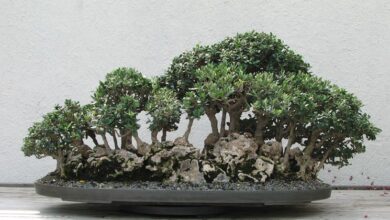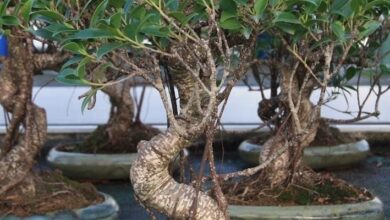What types of bonsai are there?

Knowing these classifications is very interesting, as well as necessary if you are going to work plants to make them bonsai, since even before starting the work you have to have decided how much it will measure, and also have more or less an idea of what design you will give it. So let’s go there .

Bonsai are trees or shrubs that, after years of work, have a well-defined style, a style that always tries to be a representation of a plant that we can find in nature. And the fact is that the flora, regardless of the type it is, adapts the best it can to live in its habitat, each one in his own, and by the process it can limit its growth, it can develop branches only on one side, it can twist or grow on the ground instead of standing up, or can, in short, ignore a little what their genetics say to survive.
Those who like bonsai should know that not just any plant grown in a tray will be a bonsai. This must comply with certain standards that we saw in this article. But also, it is important to bear in mind that we must try to imitate nature, respecting the tree and its cycles. If we don’t do it like that, if we want to «impose ourselves» and force him to be the one who adapts to us, I’ll tell you that sooner or later we will lose him. That being said, let’s know how bonsai are classified .
What types of bonsai are there?
Sorting according to size
Shito or Keshitsubu
It is the smallest category of bonsai that exists. The tree or shrub is less than 5 centimeters tall, which is something that is achieved by sowing the seed directly in the pot – rather pot – and pruning the seedling.
Due to size and lack of space, it usually only has one or two very short branches and a few leaves.
Mame

Image – Flickr/ Gustavo Girard
The mame bonsai measures between 5 and 15 centimeters. To get a healthy plant, you can also choose to sow the seed in the pot, or to get a cutting that we find beautiful and plant it there.
Its maintenance consists of pinching the twigs, and watering it very often so that it does not dry out.
Shohin

Image – Wikimedia/ Micro
Shohin are bonsai that measure between 15 and 25 centimeters. They are usually the easiest to find, since this is a very attractive size, and also, as the roots have a somewhat larger tray, they can get the nutrients they need so that the tree is a relatively simple plant to care for.
For all these reasons, they are the most suitable for beginners.
Komono or Kotate Mochi
These bonsai measure between 15 and 31 centimeters. Like the Shohin, they are not very difficult to maintain. With this size, I highly recommend giving them a forest style that we will now see, or the windswept ones, but you should know that anyone can look good -respecting the tree, yes-.
If we buy them ready-made, the price is usually high, so if we are not in a hurry we can get seedlings in any nursery and work them little by little.
Chumono

They are those that have a height between 30 and 60 centimeters. These are already starting to be heavy bonsai, which is why they are not seen much in fan collections. Even so, they attract a lot of attention, not only because of their size, but also because of their beauty.
Getting one is easy, but only if you go to a specialized bonsai nursery.
Omono

These are the ones that measure between 60 and 120 centimeters, like a bush growing in a normal pot. They are ideal to have in the center of a patio where we have our collection of bonsai for example, or placed on both sides of a door.
Caring for them is not much of a mystery, but transplanting them may require the hands of two people.
Hachi-uye
They are the largest of all, those with a height of more than 130 centimeters. If the Omono attracted a lot of attention, these already… I won’t even tell you . They look great on patios and terraces, either together with other bonsai of different sizes or with other types of plants.
Due to their high price, they are not usually sold much, but if you have the opportunity to get one you will surely enjoy.
Classification according to your style
Chokkan

Image – Wikimedia/ Sailko
Chokkan is the most common and easiest style of bonsai to make. It is characterized by its straight trunk and branches placed in such a way that, if we see the plant from a certain distance, we can distinguish a triangular silhouette.
Moyogi

Image – Wikimedia/ Sailko
It is very similar to the previous one, but with the difference that the trunk is not straight, but sinuous. It is also very easy to get, as there are many trees that adapt to this style, such as conifers.
Shakan

Image – Wikimedia/ Sailko
It is a tree or shrub whose trunk has been worked tilting it no more than 45º. Its cup is triangular.
Kengai

Image – Flickr/ Boyan
It is one of the most curious styles. Kengai, or waterfall, is a style in which the apex of the trunk is below the rim of the pot.
Han Kengai

Image – Wikimedia/ Sailko
Or semi-cascade. Similar to Kengai, but the apex is below the rim of the pot but above the base of the pot.
Fukinagashi

Image – Flickr/ darknesschildsin
Or swept by the wind. This style tries to imitate the trees that live in areas where the wind blows with such force and regularity that it prevents branches from growing on either side of the plant. The trunk is also inclined, in the same direction as the branches.
Neagari

Image – Wikimedia/ Keinmy
This is a style that requires knowledge and a lot of experience in bonsai cultivation, otherwise it will be difficult to maintain it. These plants grow with exposed roots, usually on a rock.
Bunjin or Literati

Image – Wikimedia/ Sage Ross
It is a style of Chinese origin, which seeks to simulate oriental calligraphy. These plants have hardly any branches, only at the apex of them, and a very slender trunk.
Sokan

Image – Wikimedia/ Dake
It is a tree with a double trunk, or «father-son.» Together they must form a kind of triangle.
Ikadabuki

Image – Wikimedia/ Sage Ross
It is the raft style, in which several branches arise from the same trunk that is semi-buried in the ground longitudinally. It works as if they were a group of trees.
Yose-Ue

Image – Wikimedia/ Ragesoss
A series of trees are planted, always in odd numbe


